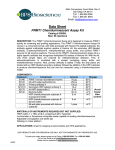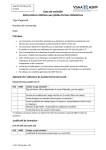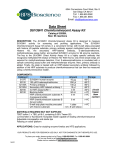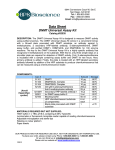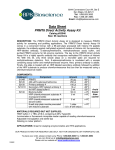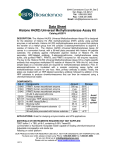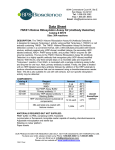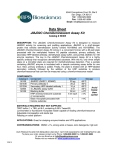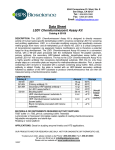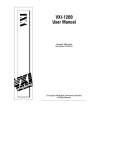Download Data Sheet - BPSBioscience.com
Transcript
6044 Cornerstone Ct. West, Ste. E San Diego, CA 92121 Tel: 1.858.202.1401 1.858.829.3082 Fax: 1.858.481.8694 Email: [email protected] Data Sheet MLL1 Complex Chemiluminescent Assay Kit Catalog #: 53008 Size: 96 reactions DESCRIPTION: The MLL1 Complex Chemiluminescent Assay Kit is designed to measure MLL1 activity for screening and profiling applications, using purified MLL1 and its complex components: WDR5, RbBP5, Ash2, and DPY30. The MLL1 Complex Chemiluminescent Assay Kit comes in a convenient format, with 8-well strips pre-coated with histone H3 peptide substrate, an antibody against methylated lysine on Histone H3, a secondary HRP-labeled antibody, S-adenosylmethionine, methyltransferase assay buffer, and enough purified MLL1 enzyme complex for 100 enzyme reactions. The key to the MLL1 Complex Chemiluminescent Assay Kit is a highly specific antibody that recognizes methylated K4 residue of Histone H3. With this kit, only three simple steps on a microtiter plate are required for methyltransferase detection. First, S-adenosylmethionine is incubated with a sample containing assay buffer and methyltransferase enzyme. Next, primary antibody is added. Finally, the plates are treated with an HRP-labeled secondary antibody followed by the addition of the HRP substrate to produce chemiluminescence that can be measured using a chemiluminescence reader. COMPONENTS: Catalog # Component 51021 MLL1/WDR5/Ash2L/RbBP5/DPY30 52120 20 µM S-adenosylmethionine 52140B2 Primary antibody 2 52160 4x HMT assay buffer 1 52130H Secondary HRP-labeled antibody 1 52100 Blocking buffer HRP chemiluminescent substrate (2 components) 96-well plate Amount 25 µg 250 µl 12.5 µl 3 ml 10 µl 50 ml 6 ml each 1 plate Storage -80°C -80°C -80°C Avoid -20°C freeze/ +4°C thaw +4°C cycles! +4°C +4°C MATERIALS REQUIRED BUT NOT SUPPLIED: TBST buffer (1 x TBS, pH 8.0, containing 0.05% Tween-20) Luminometer or fluorescent microplate reader capable of reading chemiluminescence Adjustable micropipettor and sterile tips Rotating or rocker platform APPLICATIONS: Great for studying enzyme kinetics and HTS applications. STABILITY: Up to one year from date of receipt when stored as directed. REFERENCE(S): Dillon SC, Zhang X, Trievel RC, Cheng X. Genome Biology 2005; 6:227. OUR PRODUCTS ARE FOR RESEARCH USE ONLY. NOT FOR DIAGNOSTIC OR THERAPEUTIC USE. To place your order, please contact us by Phone 1.858.829.3082 or Fax 1.858.481.8694 Or you can Email us at: [email protected] Please visit our website at: www.bpsbioscience.com 140820 6044 Cornerstone Ct. West, Ste. E San Diego, CA 92121 Tel: 1.858.202.1401 1.858.829.3082 Fax: 1.858.481.8694 Email: [email protected] ASSAY PROTOCOL: Step 1: 1) Rehydrate the microwells by adding 200 µl of TBST buffer (1x TBS, pH 8.0, containing 0.05% Tween-20) to every well. Incubate 15 minutes at room temperature. Tap the strip plate onto clean paper towels to remove liquid. 2) Thaw S-adenosylmethionine on ice. Upon first thaw, briefly spin tube containing Sadenosylmethionine to recover full contents of the tube. Aliquot S-adenosylmethionine into single use aliquots and store at -80˚C. Note: S-adenosylmethionine is very sensitive to freeze/thaw cycles. Avoid multiple freeze/thaw cycles. 3) Prepare the master mixture: N wells × (7.5 µl 4x HMT assay buffer 1 + 2.5 µl 20 µM Sadenosylmethionine + 15 µl water). Add 25 µl of master mixture to all wells labeled “Positive Control”, “Test Sample” and “Blank”. For wells labeled “Substrate control”, add 7.5 µl 4x HMT assay buffer 1 + 17.5 µl water. Blank 4x HMT assay buffer 1 20 µM S-adenosylmethionine H2O Test Inhibitor Inhibitor buffer (no inhibitor) 1x HMT assay buffer 1 Diluted MLL1 (2.5-12.5 ng/µl) 7.5 µl 2.5 µl 15 µl − 5 µl 20 µl Total 50 µl Substrate Control 7.5 µl − 17.5 µl − 5 µl − 20 µl Positive Control 7.5 µl 2.5 µl 15 µl − 5 µl − 20 µl Test Sample 7.5 µl 2.5 µl 15 µl 5 µl 50 µl 50 µl 50 µl − 20 µl 4) Add 5 µl of inhibitor solution to each well designated “Test Inhibitor”. 5) For the “Positive Control", “Substrate Control” and “Blank”, add 5 µl of the same solution without inhibitor (inhibitor buffer). 6) Thaw MLL1 enzyme on ice. Upon first thaw, briefly spin tube containing enzyme to recover full contents of the tube. Aliquot MLL1 enzyme into single use aliquots. Store remaining undiluted enzyme in aliquots at -80°C. Note: MLL1 enzyme is very sensitive to freeze/thaw cycles. Do not re-use thawed aliquots or diluted enzyme. 7) Dilute MLL1 enzyme in 1x HMT assay buffer 1 to 2.5-12.5 ng/µl (50-250 ng/20 µl). Keep diluted enzyme on ice until use. Discard any unused diluted enzyme after use. Note: Diluted enzyme may not be stable. Dilute the enzyme immediately before use. OUR PRODUCTS ARE FOR RESEARCH USE ONLY. NOT FOR DIAGNOSTIC OR THERAPEUTIC USE. To place your order, please contact us by Phone 1.858.829.3082 or Fax 1.858.481.8694 Or you can Email us at: [email protected] Please visit our website at: www.bpsbioscience.com 140820 6044 Cornerstone Ct. West, Ste. E San Diego, CA 92121 Tel: 1.858.202.1401 1.858.829.3082 Fax: 1.858.481.8694 Email: [email protected] 8) Add 20 µl of 1x HMT assay buffer 1 to the wells designated "Blank". 9) Initiate reaction by adding 20 µl of diluted MLL1 enzyme to the wells designated “Positive Control”, "Substrate Control", and "Test Sample ". Incubate at room temperature for one hour. 10) Remove the supernatant from the wells and wash the strip three times with 200 µl TBST buffer. Blot dry onto clean paper towels 11) Add 100 µl of Blocking buffer to every well. Shake on a rotating platform for 10 minutes. Remove supernatant as described above. Step 2: 1) Dilute “Primary antibody 2” 800-fold with Blocking buffer. 2) Add 100 µl per well. Incubate 1 hour at room temperature with slow shaking. 3) Wash plate three times with TBST buffer and incubate in Blocking buffer as in steps 1-10 and 1-11. Step 3: 1) Dilute “Secondary HRP-labeled antibody 1” 1,000-fold with Blocking buffer. 2) Add 100 µl per well. Incubate for 30 min. at room temperature with slow shaking. 3) Wash plate with TBST buffer and incubate in Blocking buffer as in steps 1-10 and 1-11. 4) Just before use, mix on ice 50 µl HRP chemiluminescent substrate A and 50 µl HRP chemiluminescent substrate B. Add 100 µl per well. Discard any unused chemiluminescent reagent after use. 5) Immediately read sample in a luminometer or microtiter-plate capable of reading chemiluminescence. Blank value is subtracted from all other values. Reading Chemiluminescence: Chemiluminescence is the emission of light (luminescence) which results from a chemical reaction. The detection of chemiluminescence requires no wavelength selection because the method used is emission photometry and is not emission spectrophotometry. OUR PRODUCTS ARE FOR RESEARCH USE ONLY. NOT FOR DIAGNOSTIC OR THERAPEUTIC USE. To place your order, please contact us by Phone 1.858.829.3082 or Fax 1.858.481.8694 Or you can Email us at: [email protected] Please visit our website at: www.bpsbioscience.com 140820 6044 Cornerstone Ct. West, Ste. E San Diego, CA 92121 Tel: 1.858.202.1401 1.858.829.3082 Fax: 1.858.481.8694 Email: [email protected] To properly read chemiluminescence, make sure you are using your plate reader in a LUMINESCENCE mode. Typical integration time is 1 second, delay after plate movement is 100 msec. Make sure you don’t have filter when emit the light (Synergy 2 BioTek: use “hole” position on filter wheel). Optics position – Top. Read type: endpoint. Sensitivity may be adjusted based on luminescence of a control without enzyme (typically we set this value as 100 when using Synergy 2 plate reader). Example of Assay Results: MLL1 complex enzyme activity, measured using the MLL1 Complex Chemiluminescent Assay Kit, BPS Bioscience #53008. Luminescence was measured using a Bio-Tek fluorescent microplate reader. Data shown is lot-specific. For lot-specific information, please contact BPS Bioscience, Inc. at [email protected] RELATED PRODUCTS Product Name MLL1/WDR5/Ash2L/RbBP5/DPY30 G9a (expressed in E. coli) G9a (expressed in Sf9 cells) G9a Assay Kit SUV39H1 SUV39H2 SUV39H1 Assay Kit SUV39H2 Assay Kit EZH1/EED/SUZ12/RbAp48/AEBP2 EZH2/EED/SUZ12/RbAp48/AEBP2 EZH2 Assay Kit Catalog # 51020 51000 51001 52001 51070 51080 52006 52007 51007 51004 52009 Size 50 µg 50 µg 20 µg 96 reactions 50 µg 50 µg 96 reactions 96 reactions 50 µg 50 µg 96 reactions OUR PRODUCTS ARE FOR RESEARCH USE ONLY. NOT FOR DIAGNOSTIC OR THERAPEUTIC USE. To place your order, please contact us by Phone 1.858.829.3082 or Fax 1.858.481.8694 Or you can Email us at: [email protected] Please visit our website at: www.bpsbioscience.com 140820 6044 Cornerstone Ct. West, Ste. E San Diego, CA 92121 Tel: 1.858.202.1401 1.858.829.3082 Fax: 1.858.481.8694 Email: [email protected] TROUBLESHOOTING GUIDE Problem Possible Cause Solution Luminescence signal of MLL1 enzyme has lost Enzyme loses activity upon repeated positive control reaction is activity freeze/thaw cycles. Use fresh enzyme weak (MLL1 complex, BPS Bioscience #51021). Store enzyme in single-use aliquots. Increase time of enzyme incubation. Increase enzyme concentration. Antibody reaction is Increase time for antibody incubation. insufficient Avoid freeze/thaw cycles of antibodies. Incorrect settings on Refer to instrument instructions for instruments settings to increase sensitivity of light detection. See section on “Reading Chemiluminescence” above. Chemiluminescent Chemiluminescent solution should be reagents mixed too soon used within 15 minutes of mixing. Ensure both reagents are properly mixed. Luminescent signal is erratic Inaccurate Run duplicates of all reactions. or varies widely among wells pipetting/technique Use a multichannel pipettor. Use master mixes to minimize errors. Bubbles in wells Pipette slowly to avoid bubble formation. Tap plate lightly to disperse bubbles; be careful not to splash between wells. Background (signal to noise Insufficient washes Be sure to include blocking steps after ratio) is high wash steps. Increase number of washes. Increase wash volume. Increase Tween-20 concentration to 0.1% in TBST. Sample solvent is Run negative control assay including inhibiting the enzyme solvent. Maintain DMSO level at <1% Increase time of enzyme incubation. Results are outside the Use different concentrations of enzyme linear range of the assay (MLL1 complex, BPS Bioscience #51021) to create a standard curve. OUR PRODUCTS ARE FOR RESEARCH USE ONLY. NOT FOR DIAGNOSTIC OR THERAPEUTIC USE. To place your order, please contact us by Phone 1.858.829.3082 or Fax 1.858.481.8694 Or you can Email us at: [email protected] Please visit our website at: www.bpsbioscience.com 140820





